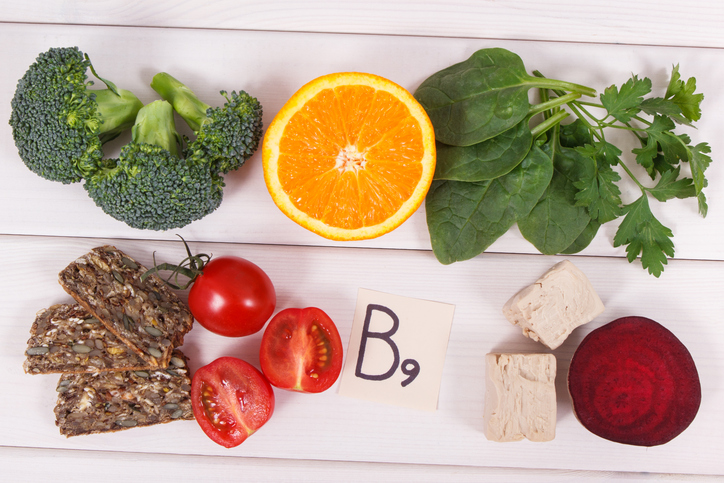- solen.sk - Folic acid and congenital developmental defects
- apps.szu.cz - portal about folic acid
With folic acid to the longed-for baby and healthy blood vessels?

Folic acid is particularly important in the context of pregnancy and is important in the prevention of developmental defects and spina bifida. However, like all vitamins, it has many more positive effects on the body.
Article content
- What is the difference between the names folate and folic acid?
- The need for folic acid for our body
- When can folic acid deficiency be considered
- Where to find folic acid
- What should be the optimal intake of folic acid
- Can too high doses of folic acid do harm?
- How to preserve the folic acid content of foods
Folic acid was discovered in the 1940s by extracting it from spinach.
It is a vitamin that belongs to the group of hydrophilic vitamins, i.e. water-soluble vitamins. It includes all the B vitamins and vitamin C. They are characterised by the fact that they are easily absorbed from the intestines into the blood, but are easily lost from foods when they are processed. The body does not store any excess, but excretes it in the urine within 24 hours.
What is the difference between the names folate and folic acid?
We encounter vitamin B9 in two different forms. The one found naturally in plant and animal foods is called folate. The body uses it in its unchanged form.
The version of vitamin B9 that is artificially created and added to foods or supplements is called folic acid. It can be added to flour or cereals, for example.
The need for folic acid for our body
The positive effects of folic acid are mainly associated with pregnancy and the proper development of the foetus. However, this vitamin also has many other beneficial effects.
Synthesis - formation of DNA and RNA
DNA and RNA (nucleic acids) are substances that are responsible for the organisation and reproduction of living matter. They carry genetic information. They are the basic building blocks of an organism. They contain genes and chromosomes, of which folic acid is an important part.
Proper fetal development
The vertebral column is made up of individual vertebrae. Normally, the vertebra is formed by the fusion of two vertebral arches. In the centre, a hole is formed in which the spinal cord is located.
In a cleft, the vertebrae do not close during intrauterine development. This creates a cleft, the so-called neural tube defect. This phenomenon is also called spina bifida. This disorder is also associated with folic acid deficiency.
The most risky period of pregnancy is the first trimester, i.e. the first three months. During this intrauterine development, all the organs of the fetus are formed and develop. The foundation of the baby's entire organ system is underway.
Folic acid deficiency in pregnancy poses an increased risk of miscarriage or premature birth. Many experts recommend taking folic acid several months before a planned pregnancy.

Other disorders where folic acid deficiency may be a risk factor include congenital heart defects, bladder disorders, or cleft lip and palate.
You may also be interested in this article on the incidence of influenza in pregnancy.
Processes of cell growth and division
It is not only the growing baby under the mother's heart that needs this vitamin. It is important for all processes of cell division and formation. It therefore contributes to the proper function and renewal of the human body, muscle formation and wound healing.
Formation of white and red blood cells
White blood cells are an important guard and defence of our body. They are an integral part of the immune system. Red blood cells are the carriers of oxygen throughout the body. They are indispensable for the oxygenation and life of the cells, i.e. the whole body.
Folic acid is involved in the development and growth of white blood cells. In the bone marrow, it is involved in the formation of red blood cells together with iron and vitamin B12.
Prevention of cardiovascular disease
The digestion of protein produces a substance called homocysteine. Like cholesterol, high levels of homocysteine in the blood are a factor in the development of heart and vascular disease. Folic acid is involved in the metabolism of this substance and, together with vitamins B6 and B12, breaks down harmful homocysteine.
You may also be interested in this article on lifestyle after a heart attack.
Appetite
Like other B vitamins, folic acid increases appetite. It is also involved in the production of stomach acid, thereby aiding digestion.
Contributes to mental health
Folic acid is also involved in the proper functioning of the psyche. A deficiency of B vitamins, especially B9 and B12, may be closely related to depression. Folic acid also relieves feelings of exhaustion and fatigue.

When can folic acid deficiency be considered
A deficiency can manifest itself in a variety of symptoms. Many are non-specific, ranging from weakness or headaches to serious disorders.
Here is a list of the most common symptoms of vitamin deficiency:
- neural tube defects, cleft lip and palate during intrauterine development
- low birth weight of the baby
- risk of premature birth or miscarriage
- congenital heart defects
- anaemia
- food aversion, diarrhoea
- weakness
- irritability, depression, insomnia
- increases the risk of cardiovascular disease
- risk of cancer
- inflammation of the tongue and mouth ulcers
- greying of hair
Where to find folic acid
Folic acid is found in vegetables, especially leafy ones, fruits and meat. Its biggest source is yeast.
Sources of folic acid:
- Yeast
- Meat: chicken and turkey liver, pork liver
- fruit: melon, oranges, raspberries, strawberries, blackberries, blueberries, avocados, papaya, banana
- Vegetables: tomatoes, radish, spinach, leeks, soybeans, beans, chicory, asparagus, cabbage, kale, broccoli, cauliflower, peppers, tomatoes, lettuce, carrots
- other: cereals, sunflower seeds, egg yolk, legumes, soya, peanuts, walnuts and hazelnuts
In addition to these natural sources, folic acid is also added to some foods. This includes some vegetable butters or cereal products, but also baked goods. Beverages include some yogurt drinks and juices.
What should be the optimal intake of folic acid
The recommended daily intake of folic acid is 400 micrograms for adults. Before a planned pregnancy and during pregnancy, some experts recommend increasing the intake up to twice as much.
According to some research, women who took 800 micrograms of folic acid a month before pregnancy and during the first three months of pregnancy had a 72% reduction in the risk of spina bifida.
There are other cases where it is recommended to increase the intake of vitamin B9. This is especially for people with digestive disorders, epilepsy and dialysis patients.
Can too high doses of folic acid do harm?
The symptom of hypervitaminosis (too much of the vitamin) does not occur with folic acid taken in its natural form in food. However, there is increasing discussion about the harmful effects of excessive folic acid in artificial form. Studies talk particularly about the risk of cardiovascular or cancer.
The benefit of folic acid for the prevention of birth defects is undeniable, but as with everything - nothing is good to overdo. Especially in pregnancy, it is better to avoid excessive use of the pill form of folic acid.

In pregnancy, it is better to indulge in fresh vegetables or fruits rich in folic acid. It is safer than taking large amounts of pills containing it.
How to preserve the folic acid content of foods
Folic acid (vitamin B9) is very volatile. It is destroyed by heat, by contact with air or by oxidation when in contact with certain metals. Thus, it is easily lost, not only when foods are cooked but also when they are stored improperly.
Principles to prevent the destruction of vitamin B9 from food:
- eat vegetables and fruit as soon as possible after harvesting
- store vegetables in the refrigerator
- do not put vegetable salads in metal bowls
- do not cut lettuce, but tear it
- cooking should be as short as possible, ideally in a little water or steamed
Potraviny s najväčším zdrojom vitamínov
Interesting resources
Related










